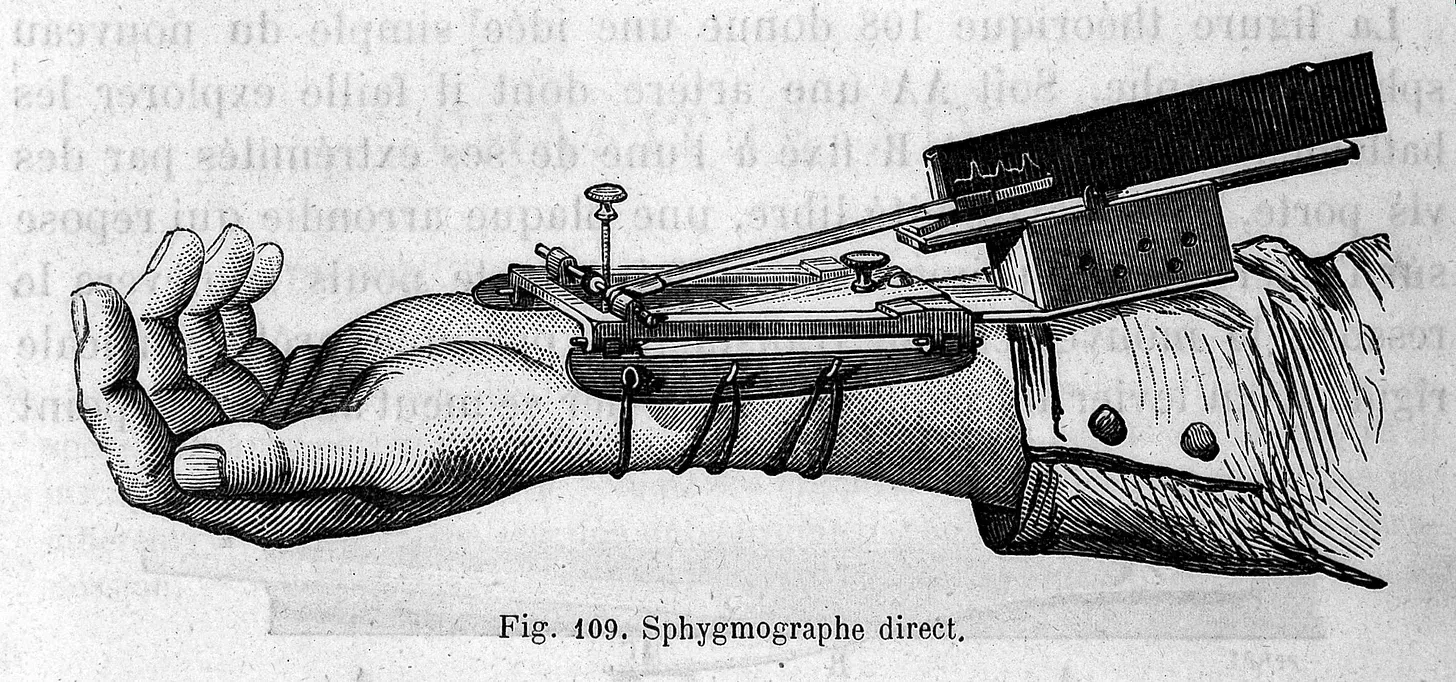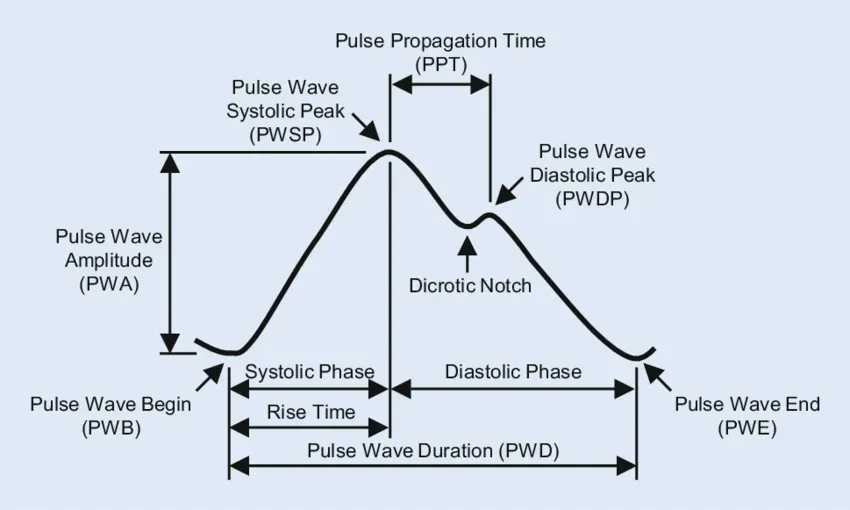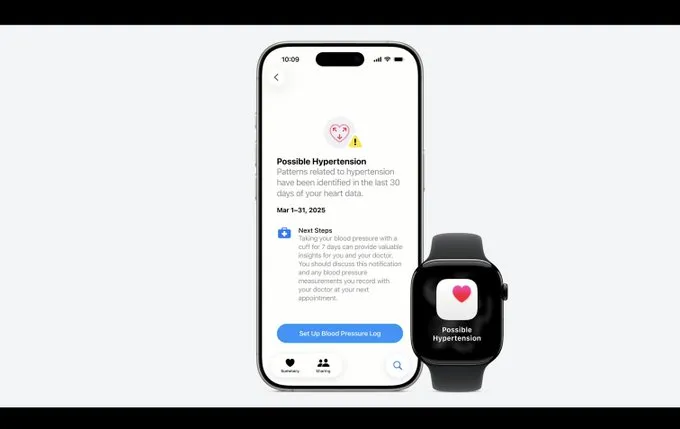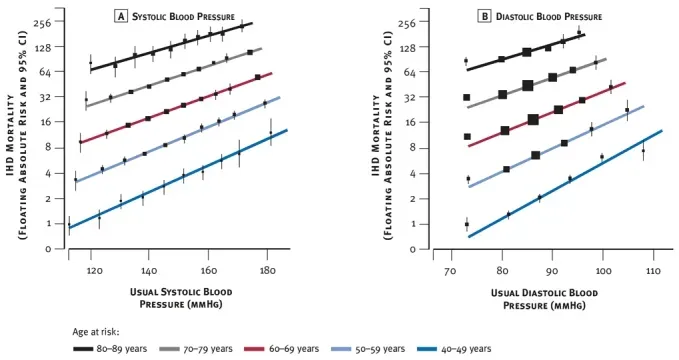Updated Sep and Oct 2025 with new details on how Apple Watch’s blood pressure detection works
Apple just announced that Apple Watch will now track high blood pressure using its heart rate sensor. This followed rumors rumors in 2023, as well as announcements of blood pressure-related features in both Whoop 5.0 and Galaxy Watch.
In 2018, I helped run one of the first studies to show that health sensor data from wearables like Apple Watch, when combined with a deep neural network, can pick up on signs of high blood pressure, sleep apnea, atrial fibrillation, and more. While the sensors have advanced in the last 7 years, the underlying science remains the same—and offers clues to the future.
In this post, I’ll try to explain the science behind tracking blood pressure on the wrist (e.g., pulse wave velocity), past medical literature on using deep neural networks to glean signal from consumer wearables, likely limitations of Apple Watch’s blood pressure feature, and how doctors and patients can incorporate it into medical practice. If you’ve received an Apple Watch hypertension alert, here’s what to do.
Pulse Wave Analysis: how Apple Watch can measure blood pressure on the wrist
When your heart beats, it sends a pressure wave—your pulse—throughout your body. As far back as antiquity, doctors could roughly sense blood pressure by pressing their finger against an artery. The first machine for measuring blood pressure, the sphygmograph, was invented in 1854. The modern modern blood pressure cuff, or sphygmomanometer, is its descendant.

Sphygmomanometers require actively pressing the artery to measure pressure.
But what if you can’t apply force to the artery? On a watch, you only have an optical sensors, which are nearly touchless. But there are still clues that let you infer blood pressure from speed and shape of each pulse wave.
Pulse Wave Velocity (PWV) is the speed at which the pulse propagates through the circulatory system. Similar to a string being pulled taut, when your blood pressure is higher, the wave travels faster.
If the Watch measures the precise times when (a) the heart contracts and (b) the pulse wave arrives at the wrist, then the difference tells you how your blood pressure is changing throughout the day. You can measure the exact time of the heart beat through an ECG (which Apple Watche, Samsung Galaxy watches, Fitbit, etc already have) or through the body’s mechanical response to the blood ejected from the heart during each heartbeat (this is called a ballistocardiogram).

Second, the shape of the wave offers indirect clues to blood pressure. The pulse rise time and the various wave amplitudes (pulse wave amplitude, pulse wave systolic peak, etc) correlate with blood pressure. All else being equal, a higher amplitude and a faster rise time correlate with more arterial stiffness and higher blood pressure.
Apple Watch blood pressure uses deep learning
Deep learning algorithms can extract even more signal. Eric Topol has written on machine eyes, where deep neural networks can spot subtle signs of disease from an ECG. Similar deep learning algorithms are used in Apple Watch’s heart rate sensing algorithm and VO2Max algorithm.
 Flow diagram of Apple Watch’s blood pressure detection feature, with steps for deep learning and post-processing.
Flow diagram of Apple Watch’s blood pressure detection feature, with steps for deep learning and post-processing.
The Apple Watch’s hypertension algorithm uses a deep learning model at its core (step 1 in the diagram above). According to Apple, it uses a “self-supervised learning method” (source) which builds on Apple’s wearable foundation model published at ICLR 2024. In short, the Apple wearable foundation model is trained to identify whether two snippets of raw optical heart rate data (PPG signals 60 seconds in duration) come from the same or different participants. Remarkably, such a simple pretraining process yielded a deep learning model that could detect high blood pressure, medication usage, age, diabetes, and so on. One other remarkable detail is how small these wearable foundation models are: just 3.3 million parameters, compared to 21 billion for OpenAI’s open source LLMs. (GPT-5 is estimated to have 330 billion parameters.)
Apple used blood pressure cuff data from 9,800 participants to adapt the foundation model to specifically predict blood pressure (Step 2). Then, scores in a 30-day window are used to determine whether to actually send a hypertension alert (Step 3).
Accuracy of Apple Watch hypertension notifications
In data submitted to the FDA, Apple Watch’s hypertension notifications had a sensitivity of 41.2%. In other words, the algorithm detects 41.2% of all hypertension and 53% of stage II hypertension. This means that if you don’t get a hypertension notification, you still may have hypertension—so double check with a cuff. In spite of this limitation, [experts still think it will boost treatment] (https://www.statnews.com/2025/09/23/apple-hypertension-app-benefits-despite-limitations/) since hypertension often goes undiagnosed.
The specificity was 92.3%. This means that if you do get a hypertension notification, it’s likely accurate and you should follow up with a doctor.
Apple Watch detects high blood pressure, but not necesssarily a quantity
Over time, your blood pressure can drift. And every person’s parameters are a bit different. So wrist-based blood pressure needs to be calibrated initially by comparing them to a blood pressure cuff. Apple has partly worked around this limitation by designing their feature to alert you to high blood pressure (hypertension), rather than detecting day-to-day changes in blood pressure.
 Apple Watch hypertension notifications. These detect high blood pressure, but don’t give a numerical blood pressure reading
Apple Watch hypertension notifications. These detect high blood pressure, but don’t give a numerical blood pressure reading
Hypertension notifications are available on Apple Watch Series 9, 10, and 11, Apple Watch Ultra 2, and Apple Watch Ultra 3. You need watchOS 26 ( released September 15, 2025). Hypertension notifications aren’t available on the Apple Watch SE3.
Health implications of Apple Watch’s blood pressure monitoring
So why does tracking blood pressure on the wrist matter? Isn’t taking blood pressure part of the typical doctor visit?
120 million people in the US are diagnosed with high blood pressure. Only 23% have it under control.
That means 77% of patients don’t have their blood pressure under control. These figures are from HHS, the American College of Cardiology, and the American Heart association. Blood pressure control often requires both stacking multiple medications and dietary changes that are challenging to achieve.
High blood pressure causes heart attacks

Alongside cholesterol or apoB, high blood pressure is one of main risk factors for a heart attack.
Every 20 mmHg increase in your systolic blood pressure, or 10 mmgHg increase in diastolic blood pressure, doubles your mortality.
To make it concrete — let’s say you’re a 40 year old man with good cholesterol numbers (160 total cholesterol, 60 HDL). If your blood pressure is 115/75 (good), your lifetime risk of a heart attack is only 5%. If your blood pressure is 150/110 (high), your lifetime risk is 10x higher — 50% (source).
Blood pressure is sensitive to daily, counterintuitive nutritional choices
People with high blood pressure are often recommended the DASH diet, where you try to eat 3,500 to 5,000 mg of potassium per day and under 1,500 mg of sodium. It’s surprisingly difficult to control your dietary potassium and sodium, however, since the set of foods are counterintuitive.
Hint: bananas don’t even make the top 10 of high-potassium foods. The set of high-potassium foods is very heterogenous—spinach, avocado, sweet potato, and white beans are all among the top 10. Sodium is even more insidious — much of our consumption comes from things like bread, which don’t necessarily taste salty.
Continuous glucose monitors have revolutionized treatment for those with diabetes. Could a continuous blood pressure monitor give similar, real-time feedback on dietary choices? With the benefit of AI, you can imagine that everybody would have a virtual nutritionalist.
Can I add blood pressure to Apple Health today?
Yes, you can add blood pressure to Apple Health using an external blood pressure cuff, such as a Withings cuff. These will automatically sync systolic and diastolic blood pressure measurements to the Apple Health app, and apps such as Empirical Health for Apple Watch which integrate with Apple Health.
How to pair your Apple Watch with a blood pressure cuff
If you have an earlier Apple Watch model, you can pair an Apple Watch with external, cuff-based blood pressure monitor. If you do this, Apple Watch health apps like Empirical Health can help you comprehensively manage your hypertension. For most people with hypertension, their care plan will include not just blood pressuremonitoring, but also medication and dietary changes (like the DASH diet).
![]() Tracking foods that raise or lower blood pressure in Empirical Health.
Tracking foods that raise or lower blood pressure in Empirical Health.
What’s next?
The Apple Watch tracks dozens of health metrics, including HRV, VO2 Max (cardio fitness), oxygen (Spo2), heart rate recovery, and more. Hypertension is one of the most powerful.
And if you want to manage your hypertension and overall heart health using your Apple Watch data, try out Empirical Health on the App Store today.
Get your free 30-day heart health guide
Evidence-based steps to optimize your heart health.
